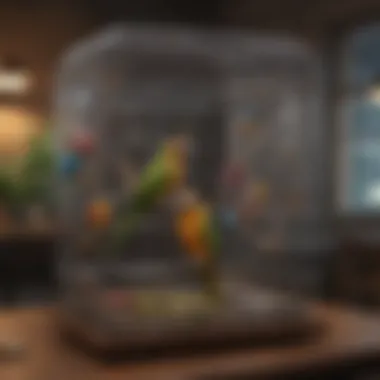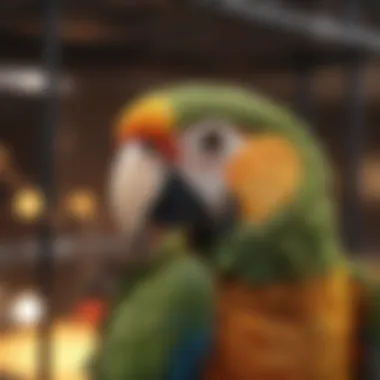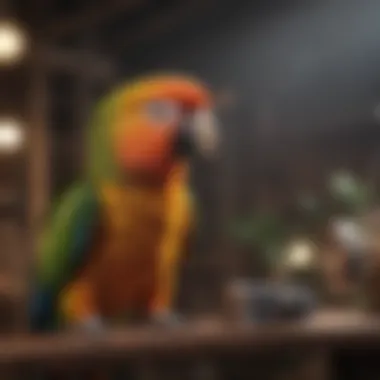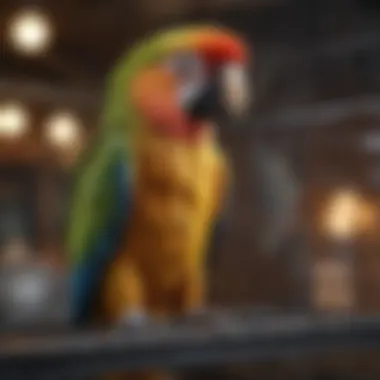Choosing the Right Medium Parrot Cage: A Comprehensive Guide


Intro
Selecting a cage for medium-sized parrots is a critical decision that significantly impacts their health and overall happiness. Parrots are social and intelligent creatures, requiring a proper environment to thrive. This guide will dissect the multifaceted considerations when choosing the appropriate parrot cage, emphasizing the importance of size, materials, and design features that curated a joyful habitat for your feathered companions.
Furthermore, it will navigate through aspects that involve maintenance, enriching activities, and behavioral traits. Hence, a thorough comprehension of these elements empowers bird enthusiasts and potential owners alike to foster a nurturing environment that lies at the very foundation of parrot well-being.
Care Tips
Caring for a medium-sized parrot requires ongoing dedication and understanding. Proper care is not just about providing the essentials; it encompasses the routines and environment that enrich their lives.
Daily Care Routines
A well-structured routine contributes immensely to a parrot’s sense of security and well-being. Account for various elements where daily interaction and health checks are essential. This includes feeding schedules, offering constant access to fresh water, and allowing time outside the cage for socialization and exercise.
Cage Setup and Maintenance
Setting up the cage involves selecting the right space and organization of perches, dishes, and toys. Considerations for airflow, light exposure, and cage location within your home are important. Maintenance routines should also be part and parcel of your plan to ensure the cage remains a safe environment. Regular checks of perches and toys help to avoid potential hazards from wear or damage.
Hygiene and Cleaning Practices
Cleanliness is imperative for parrot health. Dedicated hours for cleaning are required where droppings and uneaten food are removed promptly. Using bird-safe cleaning products will prevent toxins from posing a risk. Regularly changing bullet-in papers at the cage bottom can help to maintain hygiene.
Seasonal Care Adjustments
In colder months, special attention is needed to ensure warmth without drafts. Conversely, summer raises challenges such as heat stress. Be cautious of cage placement nearby windows whereby seasonal temperature changes can affect your parrot's comfort and safety.
Behavioral Insights
Understanding the behavioral tendencies of medium parrots is crucial in ensuring their well-being and creating a trusting relationship. Developing observational skills can help dramatically improve interactions with your feathered friend.
Understanding Bird Body Language
Parrots express much through body language. Observing tail movements, head bobbing, and vocalization volume grants insight into their feelings. Recognizing these signals will aid in responding appropriately to their needs and emotions.
Common Behavioral Issues and Solutions
Problems such as excessive screaming, biting, or feather plucking can arise from various stressors. Identifying triggers and implementing solutions can often mitigate these behaviors. For example, ensuring an ample amount of stimulation can often decrease destructive habits.
Positive Reinforcement Techniques
Utilizing positive reinforcement is effective for encouraging desired behaviors. Rewarding with treats after successful progress forms a helpful methodology to establish correct habits.
Social Interaction Needs
Social insects need interaction. Ensuring an environment that fosters play, casual talking, or even training strengthens your bond and aids emotional health.
Nutrition Guides
Providing a balanced diet is essential. Understanding what constitutes a healthy diet aids in avoiding nutritional deficiencies.
Essential Diet Components
A varied diet mainly consists of high-quality pellets complemented with fresh fruits, vegetables, seeds, and nuts. Diversifying their food source enhances their mental engagement with meals.
Safe and Toxic Foods
It's paramount to be informed about foods that can be harmful. Common toxic foods such as avocados or chocolate must be strictly avoided.
Supplements and Treats
Supplements can be beneficial, depending on individual dietary needs. Good choices include calcium powder or specialized vitamins, often integrated on a sporadic basis. Healthy treats such as cuttlefish bone can also be added for enrichment.
Feeding Strategies for Different Species


Different medium parrot species have unique dietary necessity. Researching specific requirements from reliable sources will provide suitable guidance to tailor proper nutrition. More info on diet can be found on Wikipedia.
Wellness and Health
The health of your parrot starts with routine checks and recognizing signs of disturbances in their health or behavior. Providing a routine also helps to ameliorate their quality of life.
Routine Health Checkups
Regular vet check-ups can help catch potential issues early on. This preventative step plays a critical role in maintaining your bird's health.
Identifying Symptoms of Illness
Early detection correlates to better health outcomes. Look for behaviors masked behind challenges such as changes in color, energy levels, or behavior such as lethargy or panting.
Preventative Care and Vaccinations
Preventative care is pivotal. Many vaccines are recommended to avert typical diseases in parrots. Consult a veterinarian to create an appropriate vaccination schedule based on your parrot’s lifestyle.
Mental and Emotional Well-being
Emphasizing mental health translates to happiness in parrots. Engaging mentally stimulative activities create an enriched habitat, setting your bird up for success.
Enriching Activities
Building a varied lifestyle outside of the cage promotes vitality and enrichment.
Toys and Playtime Ideas
Introduce a variety of toys that challenge their intelligence and sports. Rotate toys regularly to keep them engaged. Additionally, consider foraging toys that encourage exploration for hidden treats.
Training and Tricks
Training not only propels engagement but helps bond with your parrot. Encouraging them to learn tricks fosters their intelligence and offers entertaining sessions.
Outdoor Activities and Interaction
When appropriate clima-conditions allows, outdoor time under supervision can be beneficial. Parrots can experience various sight, sounds, and sunshine that contribute positively to their mood.
DIY Projects for Mental Stimulation
Simple Marvels such as rope perches or hiddding treats in certain crafts engages a parrot's intellect and energy, ensuring crucial development in their home with ease. Please intrigue creative aspects in each opportunity observed.
Comprehensive knowledge regarding the particular needs of medium parrot species will enhance the joy enjoyed alongside these feathered friends, doing wonders to examine proactive methodologies responsibly.
Intro to Medium Parrot Cages
Selecting an appropriate environment for medium-sized parrots is more than a mere decision; it is a commitment to their comfort and well-being. Parrots, being intelligent and social creatures, require a space that allows them to flourish physically and mentally. Therefore, the choice of a medium parrot cage becomes vital in maintaining their health and happiness.
In this article, we aim to delve into various aspects of medium parrot cages, focusing on the crucial details that go into selecting the right one. Understanding medium-sized parrots is the first step in making an informed decision regarding their habitat. This understanding provides foundational knowledge about their behaviors, which directly influences what kind of cage setup they will need. Additionally, discussing the importance of cage selection further reinforces the significance of well-thought guidelines when choosing an appropriate space for these birds.
Understanding Medium-Sized Parrots
Medium-sized parrots include various species such as the African Grey, Amazon Parrots, and Eclectus. These birds typically require a cage that supports their playfulness and need for interaction. Most medium parrots have a wingspan that can reach up to 20 inches. Hence, their cages must accommodate sufficient space for flapping, climbing, and exploring. The happiness of a parrot reflects a direct relationship between its ability to exercise and the cage's dimensions. Choosing a cage that is too small can lead to issues like stress and behavioral problems.
Socialization is another aspect where knowing specifics about medium-sized parrots pays off. They generally thrive on interaction, thus cages that facilitate communication and bonding with humans or other pets are paramount. A proper understanding of these traits sheds light on what kind of enrichment activities are necessary inside their living environments. Cages with multiple levels and expansions can help fulfill these social and physical needs by providing more play spaces.
The Importance of Cage Selection
Cage selection holds great importance as it determines how well a medium-sized parrot can adapt to its living conditions. An inadequately chosen cage can lead to physical maladies and behavior anomalies in parrots. Livelihood restrictions can result from too small or unfitting cages, compelling parrots into stress-induced behaviors.
Factors that play into this selection include size, bar spacing, material durability, and the overall design of the cage. Larger cages that allow for full wing extension can provide a safer environment for the bird to engage in natural behaviors. Likewise, proper bar spacing ensures their safety by preventing escapes and potential injuries.
Key Considerations for Cage Selection:
- Size Matters: Ensure enough height and width for full movement.
- Sturdy Materials: Check for non-toxic and durable construction.
- Accessibility: Cages should have enriching access points for play and convenience.
- Safety First: Make a note of all risks involving gaps and edges likely to cause injury.


Factors to Consider When Choosing a Medium Parrot Cage
Selecting the right cage for medium parrots is not a trivial task. It requires thoughtful consideration of various factors that directly affect the safety, health, and comfort of the bird. The dimensions, bar spacing, material durability, and shape of the cage are pivotal aspects that must be evaluated. Failing to address these elements may lead to accidents, discomfort, and long-term behavioral issues for your feathered companion. When done correctly, the right choice creates an environment that encourages well-being, exploration, and interaction.
Cage Dimensions
The dimensions of a parrot cage play a critical role in the comfort of your bird. Medium-sized parrots such as conures and amazon parrots require ample space to move, stretch, and engage in natural behaviors. A cage that is too small can lead to frustration and aggressive behavior. A minimum size often suggested for medium parrots is around 24 inches long, 24 inches wide, and 36 inches tall.
Consider setting up the cage with adequate perches and play areas as well. Ensure the dimensions facilitate easy access for you as well; frequent interaction simplifies maintenance and bonding sessions with your bird. The overall space should capture a balance between providing enough room for the parrot and easily fitting within your chosen area of your home.
Bar Spacing
Bar spacing is another crucial factor when it comes to the safety of your parrot. If the gaps between the bars are too wide, there is a risk that the parrot can escape or worse, get stuck. Ideally, the space should not exceed 1 inch. This standard prevents small heads from slipping through but allows enough space to provide ventilation. Before purchasing a cage, physically examine the spacing to ensure that it meets your specific species' needs.
Additionally, the thickness of the bars affects a bird's ability to grip. Choose sturdy bars that can withstand the natural chewing tendencies of parrots. Not only does this feature contribute to the parrot's safety, but it also plays a role in preventing the pace of their natural boredom and ensuring their long-term mental health.
Material Durability
When considering the material, durability is an essential aspect of the cage's lifespan and overall safety. Cages constructed from stainless steel tend to endure better than those made from lower-quality metals. Ownership often leads to wear and termites early on, risking the safety of your bird. Ensure the material is non-toxic and safe for long-term usage. Heavy-duty finishes can repel rust and corrosion, which is useful in a bird-living environment, often humid
While galvanized steel is also common, not all galvanized coatings are safe. It is imperative to research the product thoroughly before purchasing it. Feathered friends require safe spaces to thrive, making material choice not just a convenience, but a necessity for avoiding potential harm.
Cage Shape and Design
The space shape can influence how a parrot uses it. Traditional rectangular cages offer simplicity, yet innovative round or corner designs can create varied environments that encourage different behaviors.
Choosing a design that mimics natural habitats adds another level of enrichment. Features like multiple doors, feeding ports, and variations in perch heights can promote healthy activities. Make sure the cage design permits for ample ventilation and prevents stagnation.
Certainly, aesthetics matter to the owner, but balancing visual appeal with functionality will always yield the best outcome. Engage in further research online or talk to fellow parrot owners to gauge their experiences.
When selecting a cage for medium parrots, always prioritize safety and comfort over aesthetics.
All these highlighted factors contribute significantly to the environment your parrot will live in. Fostering a supportive atmosphere stimulates learning and well-being. Making informed decisions is an irreplaceable part of the ownership for anyone ready to raise a medium-sized parrot.
Cage Features for Enrichment and Comfort
Medium-sized parrots, such as African Grey Parrots, Quakers, and Conures, require more than just a safe space to live. The choice of cage always influences their physical and mental well-being. A thoughtfully designed cage includes features that promote enrichment and comfort. These aspects are essential as they cater to the inherent needs of companion birds.
Perches and Accessories
Perches serve as essential components in a parrot's cage. Not only do they provide a place for resting, but they also encourage healthy foot posture. When selecting perches, consider several factors. Material is one such factor. Natural wood perches are superior as they mimic trees, giving birds a sense of being in their natural habitat.
Diameter matters too. Moderately varying sizes allow birds to grip differently, which promotes sanctity of textures and weakens boredom. Consider types such as:
- Rope perches: Ideal for climbing and swinging, providing fun and exercise.
- Playtop perches: Attach these on the cage's top for added recreational space.
- Swinging perches: Engage your parrot in joyful moments while strengthening foot muscles.
Strategically place these perches at various levels in the cage to encourage exploration. Accessories, such as hammocks and ladders, can additionally enhance play behaviors and break monotony.
Feeding and Water Stations
Adequate feeding and watering arrangements significantly impact parrot health. A well-placed feed station ensures that bird can access food easily without feeling trapped or stressed. Opt for stainless steel bowls over plastic ones. They are more sanitary and harder to chew.
To further promote cleanliness, consider weighted bowls. Birds often toss food around, so having a heavier option keeps bowls in place and reduces spillage. In addition to the food bowls, a separate water bowl is vital for hydration. That promotes both physical health and emotional well-being.
Frequency of replacing food and water should be more than just routine.
- Fresh water is vital every day.
- Food should also be varied and nutritionally complete.
- And remember to invisibily check for contaminants and rontamination.
Toys and Environmental Enrichment
Interactive toys are crucial for stimulating a parrot's mind. Birds are naturally intelligent and need opportunities to solve problems. Different types of toys, like those that encourage foraging, help mimic behaviors they would experience in the wild. Some important considerations for toy selection include:
- Foraging toys: Toys that conceal food mentally engage birds while reproducing natural activities.
- Chewing toys: Beaks grow continuously. Providing toys that allow chewing can help maintain beak length.
- Movement toys: These toys sway, twirl or dangle. They entice parrot to interact through play and movement, promoting overall well-being.
Maintenance and Care of the Cage


Maintaining a medium parrot cage goes beyond keeping it visually appealing. A well-cared-for cage directly impacts the health and happiness of your bird. Regular maintenance is essential to prevent the build-up of harmful bacteria and ensure a rich environment that encourages your parrot to thrive.
Regular Cleaning Protocols
Establishing a systematic cleaning routine is vital. It not only keeps the cage tidy but also promotes hygiene. Here are some effective cleaning practices:
- Daily Spot Cleaning: Remove leftover food and waste. This helps avoid odors and contamination.
- Weekly Thorough Cleaning: Every week, perform a deep clean. Remove all accessories, including perches and toys, and wash them separately. Scrub the cage with a suitable, non-toxic toy cleaner. Rinsing thoroughly avoids any residue that can affect your bird.
- Monthly Disinfection: Once a month, disinfect the entire cage. Use a safe product recommended for pet environments. This further reduces harmful bacteria and parasites.
Following this regime encourages a healthier living space and reassures the owner of their parrot's wellbeing.
Avoiding Toxic Substances
Parrots are sensitive to many substances, and as a cage owner, you have an important responsibility to ensure their safety. Toxicity can stem from numerous sources:
- Cleaning agents: Opt for mild, non-toxic cleansers. Common household products such as bleach or ammonia can be dangerous.
- Materials: Ensuring that all parts of the cage are free from lead or zinc is crucial. These heavy metals can leach into your bird’s environment.
- Pesticides: Always check for potentially harmful chemicals around the cage. Environment safety should come first.
By being vigilant about what enters the cage area, you contribute valuably to your parrot's health and safety.
Inspecting for Wear and Damage
Regular inspections of the cage are essential to identify any wear and tear that could potentially harm your parrot. Focus on:
- Bars and Gaps: Look for gnaw marks or loose bars. These could result in escape routes or unintended injuries.
- Accessories and Toys: Check that perches or ropes haven't frayed. Worn-down toys pose ingestions risks or might become dangerous.
- Base and Fillers: Examine the base, notably for cracks. Clean or replace substrates to eliminate harmful bacteria. This precaution ensures a safe environment, showing your commitment as a responsible bird owner.
Maintaining and caring for the cage ensures a safe and enjoyable space, where your medium parrot can live happily and explore its surroundings. This attentiveness to cleaning and safety harnesses a direct link to your bird's quality of life, reinforcing a loving bird-owner relationship.
The Role of Social Interaction
The well-being of medium-sized parrots is intricately tied to their social interactions. Understanding this element is crucial for ensuring that these intelligent creatures thrive in a domestic setting. Unlike many other pets, parrots possess a natural affinity for socialization. They rely on interaction, both with their human caregivers and possibly with fellow birds. The ability to foster a stimulating and interactive environment plays a pivotal role in their overall mental and emotional health.
Understanding Bird Behavior
Medium parrots, such as African Greys and Amazon Parrots, display complex behaviors reflective of their wild counterparts. In their natural habitat, these birds engage in various social activities, including feeding, preening, and vocalizations. They form flocks, using intricate communication to establish bonds and social hierarchies. Failing to replicate this environment can lead to feelings of loneliness and potential behavioral issues such as excessive screaming or plucking.
Offering varied forms of interaction is beneficial. Here are some aspects to consider in relation to their behavior:
- Social grooming: Birds engage in mutual preening, which strengthens social bonds.
- Vocal communication: Parrots have a range of vocalizations that are essential for interaction.
- Play behavior: Interacting during play promotes mental stimulation and enjoyment.
By integrating these elements into daily routines, owners can help their parrots feel more comfortable and fulfilled in their home.
Importance of Socialization
Socialization is not merely a luxury for medium parrots; it is a fundamental need. For a parrot to flourish, regular social interaction with their human companions is vital. The following points highlight the significance of socialization:
- Emotional health: Interaction can mitigate feelings of anxiety. Parrots that feel secure in their social bonds are typically happier.
- Behavioral development: Engaging and positive interactions help parrots learn appropriate behaviors. As they socialize, they pick up on cues, adapting to the household routines.
- Cognitive stimulation: Social interaction encourages mental agility. The give-and-take of engagement helps parrots remain sharp and less bored.
In essence, neglecting social needs can result in various detrimental outcomes. It can affect not just the bird's health but also its ability to interact positively with humans.
Overall, socializing medium-sized parrots is integral to their happiness and decreases the likelihood of developing harmful behaviors. As they thrive on connection, understanding their need for interaction is key to creating an enriching home environment.
By focusing on the aspects of social interaction, bird owners can significantly improve the quality of life for their feathered companions, allowing them to display healthier and happier behaviors.
Final Considerations
Choosing the right medium parrot cage involves various considerations that ultimately affect the well-being of your bird. This section highlights the importance of carefully evaluating your choices before making a purchase. Doing so ensures you provide an environment that supports not just shelter and safety, but also quality of life. There are several elements that must be weighed, including budget constraints and key features that add long-term value.
Budgeting for a Quality Cage
Considering your budget for a medium parrot cage is a crucial step. A quality cage is an investment in your parrot’s happiness and health. Here are several points to keep in mind:
- Quality Over Price: Focus on the materials and design. A cheap cage may save you money upfront, but it could be detrimental for your bird in terms of safety and comfort in the long run.
- Features Worth Investing In: Evaluate what features are essential for your bird. Perches, drawer trays for easy cleaning, and multiple access points may be more important than a flashy design.
- Long-term Costs: Remember, the expense does not stop at the initial buying price. Think of maintenance, replacements, and what accessories you might need.
- Availability of Replacement Parts: Some brands provide better customer support and replacement options if your cage needs repair. This could save you money down the line.
End: Making an Informed Choice
Making an informed choice requires careful assessment of all factors previously discussed. Avoid impulsive decisions influenced by sales or marketing gimmicks. You want a cage that aligns with both your budget and your parrot’s needs. Remember, selecting the right medium parrot cage involves not just a consideration of size and materials, but also involves understanding the significance of every feature.
Ultimately, after weighing all the elements, you will be better equipped to select a cage that enhances the quality of life for your parrot. Informed choices lead to a nurturing environment for your bird, and ultimately, more joy for you as a pet owner.
"An effective cage multiplies opportunities for interaction, activity, and overall bird health. Thus, the decision must reflect both thoughtful planning and concern for well-being."
Invest in a quality cage. It is an essential step towards ensuring a healthy and engaging life for both you and your feathered companion.















